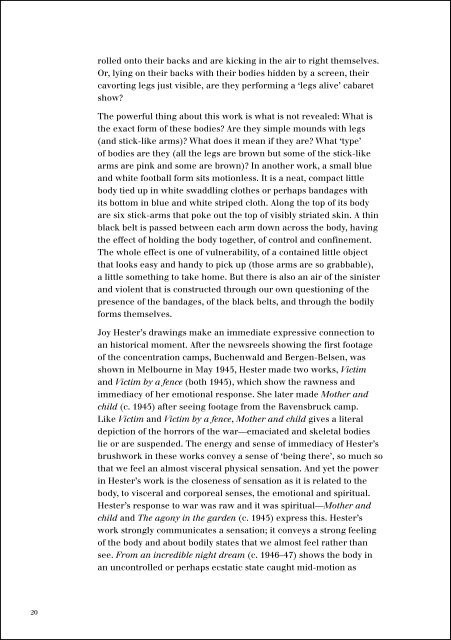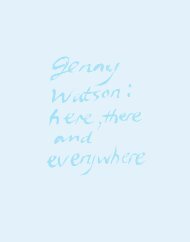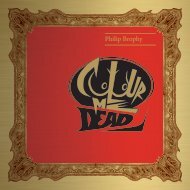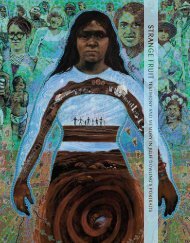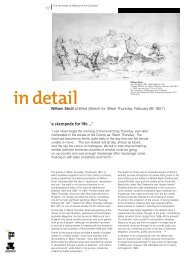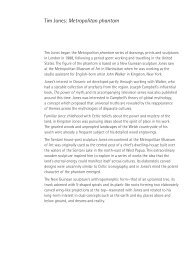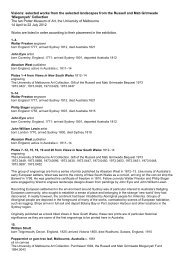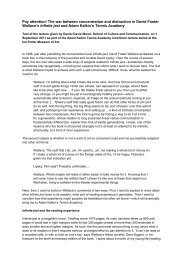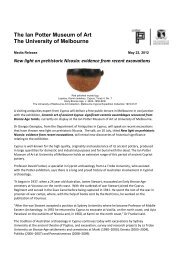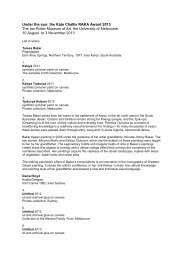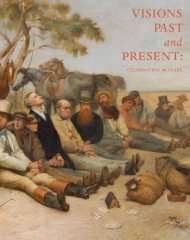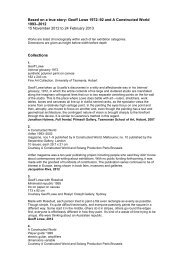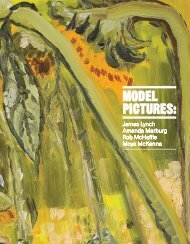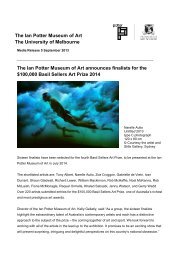The body the ruin
Catalogue - Ian Potter Museum of Art - University of Melbourne
Catalogue - Ian Potter Museum of Art - University of Melbourne
Create successful ePaper yourself
Turn your PDF publications into a flip-book with our unique Google optimized e-Paper software.
olled onto <strong>the</strong>ir backs and are kicking in <strong>the</strong> air to right <strong>the</strong>mselves.<br />
Or, lying on <strong>the</strong>ir backs with <strong>the</strong>ir bodies hidden by a screen, <strong>the</strong>ir<br />
cavorting legs just visible, are <strong>the</strong>y performing a ‘legs alive’ cabaret<br />
show?<br />
<strong>The</strong> powerful thing about this work is what is not revealed: What is<br />
<strong>the</strong> exact form of <strong>the</strong>se bodies? Are <strong>the</strong>y simple mounds with legs<br />
(and stick-like arms)? What does it mean if <strong>the</strong>y are? What ‘type’<br />
of bodies are <strong>the</strong>y (all <strong>the</strong> legs are brown but some of <strong>the</strong> stick-like<br />
arms are pink and some are brown)? In ano<strong>the</strong>r work, a small blue<br />
and white football form sits motionless. It is a neat, compact little<br />
<strong>body</strong> tied up in white swaddling clo<strong>the</strong>s or perhaps bandages with<br />
its bottom in blue and white striped cloth. Along <strong>the</strong> top of its <strong>body</strong><br />
are six stick-arms that poke out <strong>the</strong> top of visibly striated skin. A thin<br />
black belt is passed between each arm down across <strong>the</strong> <strong>body</strong>, having<br />
<strong>the</strong> effect of holding <strong>the</strong> <strong>body</strong> toge<strong>the</strong>r, of control and confinement.<br />
<strong>The</strong> whole effect is one of vulnerability, of a contained little object<br />
that looks easy and handy to pick up (those arms are so grabbable),<br />
a little something to take home. But <strong>the</strong>re is also an air of <strong>the</strong> sinister<br />
and violent that is constructed through our own questioning of <strong>the</strong><br />
presence of <strong>the</strong> bandages, of <strong>the</strong> black belts, and through <strong>the</strong> bodily<br />
forms <strong>the</strong>mselves.<br />
Joy Hester’s drawings make an immediate expressive connection to<br />
an historical moment. After <strong>the</strong> newsreels showing <strong>the</strong> first footage<br />
of <strong>the</strong> concentration camps, Buchenwald and Bergen-Belsen, was<br />
shown in Melbourne in May 1945, Hester made two works, Victim<br />
and Victim by a fence (both 1945), which show <strong>the</strong> rawness and<br />
immediacy of her emotional response. She later made Mo<strong>the</strong>r and<br />
child (c. 1945) after seeing footage from <strong>the</strong> Ravensbruck camp.<br />
Like Victim and Victim by a fence, Mo<strong>the</strong>r and child gives a literal<br />
depiction of <strong>the</strong> horrors of <strong>the</strong> war—emaciated and skeletal bodies<br />
lie or are suspended. <strong>The</strong> energy and sense of immediacy of Hester’s<br />
brushwork in <strong>the</strong>se works convey a sense of ‘being <strong>the</strong>re’, so much so<br />
that we feel an almost visceral physical sensation. And yet <strong>the</strong> power<br />
in Hester’s work is <strong>the</strong> closeness of sensation as it is related to <strong>the</strong><br />
<strong>body</strong>, to visceral and corporeal senses, <strong>the</strong> emotional and spiritual.<br />
Hester’s response to war was raw and it was spiritual—Mo<strong>the</strong>r and<br />
child and <strong>The</strong> agony in <strong>the</strong> garden (c. 1945) express this. Hester’s<br />
work strongly communicates a sensation; it conveys a strong feeling<br />
of <strong>the</strong> <strong>body</strong> and about bodily states that we almost feel ra<strong>the</strong>r than<br />
see. From an incredible night dream (c. 1946–47) shows <strong>the</strong> <strong>body</strong> in<br />
an uncontrolled or perhaps ecstatic state caught mid-motion as<br />
{<br />
it curls awkwardly across <strong>the</strong> paper. It is almost as if a sympa<strong>the</strong>tic<br />
physical recognition is communicated in a bodily ra<strong>the</strong>r than visual<br />
manner. It is this that best highlights <strong>the</strong> ‘stuff’ of Hester’s work, <strong>the</strong><br />
sense that <strong>the</strong> physical, visceral and sensual <strong>body</strong> is at <strong>the</strong> centre of<br />
things.<br />
In his essay on Francis Bacon, Deleuze writes of sensation that:<br />
... it is Being-in-<strong>the</strong>-World, as <strong>the</strong> phenomenologists say: at one and<br />
<strong>the</strong> same time I become in <strong>the</strong> sensation and something happens<br />
through <strong>the</strong> sensation, one through <strong>the</strong> o<strong>the</strong>r, one in <strong>the</strong> o<strong>the</strong>r. And<br />
at <strong>the</strong> limit, it is <strong>the</strong> same <strong>body</strong> which, being both subject and object,<br />
gives and receives <strong>the</strong> sensation. 12<br />
And it is to this <strong>body</strong> as both ‘subject and object of sensation’ that<br />
I would like to finally return. I’ve wanted to reflect on <strong>the</strong> way we<br />
ourselves might understand (as in ‘feel’ or ‘be conscious of’) our<br />
bodies as a mechanical entity but also as a thing that feels and<br />
expresses itself, as an active protagonist in <strong>the</strong> construction of<br />
meaning and sensation. Deleuze describes <strong>the</strong> <strong>body</strong> as having a<br />
language of its own and being able to ‘speak’, and this sense of <strong>the</strong><br />
<strong>body</strong> that speaks a language expressed through gesture (and through<br />
our reading and shared understanding of this gesture) can be seen<br />
as both a continuum of and reaction to various modernist attitudes<br />
to <strong>the</strong> <strong>body</strong>. <strong>The</strong> twentieth century almost began with <strong>the</strong> Futurists’<br />
cry—‘<strong>the</strong> <strong>body</strong> is a machine!’—and <strong>the</strong> <strong>body</strong> has certainly been a<br />
continuing human preoccupation. <strong>The</strong> wounded <strong>body</strong>, mutilated by<br />
war, could be seen as <strong>the</strong> fulcrum around which <strong>the</strong> status and value<br />
of <strong>the</strong> <strong>body</strong> have revolved since this time. Questions of <strong>the</strong> natural<br />
and post-natural <strong>body</strong>, of <strong>the</strong> relationship between <strong>the</strong> <strong>body</strong> and <strong>the</strong><br />
image, and <strong>the</strong> fundamental experience of <strong>the</strong> <strong>body</strong> as ‘Being-in-<strong>the</strong>-<br />
World’ cannot but be invigorated by <strong>the</strong> war-pornography created by<br />
US soldiers serving in Iraq and Afghanistan. For example, <strong>the</strong> posting<br />
of images of <strong>the</strong> bodies of people <strong>the</strong>y have just killed or maimed on<br />
<strong>the</strong> internet. 13<br />
20 21


